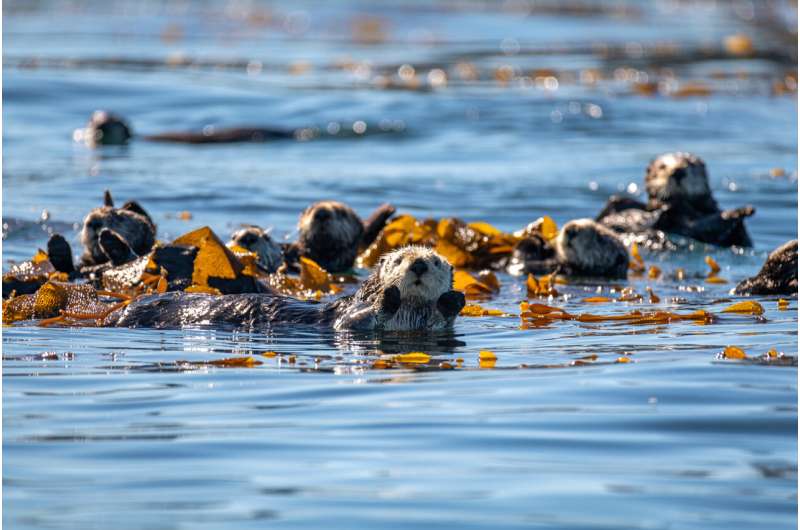This article has been reviewed according to Science X's editorial process and policies. Editors have highlighted the following attributes while ensuring the content's credibility:
fact-checked
peer-reviewed publication
trusted source
proofread
New study shows sea otters helped prevent widespread California kelp forest declines over the past century

Monterey Bay Aquarium researchers strengthen the link between sea otters and long-term health of California kelp forests in a new study released today. The paper, published in the journal PLOS Climate, finds that sea otter population growth during the last century enhanced kelp forest resilience in the state.
This finding reinforces the importance of conservation and recovery of the threatened southern sea otter and highlights a potential nature-based solution for restoring kelp forests along the California coast, and perhaps beyond.
The study revealed dramatic regional kelp canopy changes over a 100-year period, from 1910 to 2016. During this time there was a significant increase in kelp forest canopy along the central coast, the only region of California where southern sea otters survived after being hunted nearly to extinction for their fur in the 1800s. At the century scale, the species' favorable impact on kelp forests along the central coast nearly compensated for kelp losses along both northern and southern California resulting in a slight overall decline statewide during this period.
"Our study showed that kelp forests are more extensive and resilient to climate change where sea otters have reoccupied the California coastline during the last century. Where sea otters are absent, kelp forests have declined dramatically. In fact, we found sea otter population density as the strongest predictor of change in kelp canopy coverage across this hundred-year span," said lead author Teri Nicholson, Senior Research Biologist with the Monterey Bay Aquarium Sea Otter Program.
Aquarium scientists used historical surveys of kelp forests dating back to the early 1900s to perform detailed estimates of canopy extent, biomass, and carbon storage—while correcting for annual variation and differences in survey methods.
This allowed the scientists to examine California's kelp forest trends over a longer time period, going back more than 60 years before available data from modern surveys based on aerial or satellite imagery. The team then compared the corrected and conservative historical estimates to contemporary datasets and used a machine learning framework to assess the dominant drivers of change over the last century.
"The use of historical maps provided an important opportunity to help us examine long-term kelp forest trends," said Monterey Bay Aquarium Sea Otter Program Manager, Jess Fujii. "This broader view is important for understanding trends related to climate change, and developing effective science-based conservation strategies."
Statewide, the data showed only a 6% decline in kelp canopy from 1910 to 2016. Regional changes, however, proved more sizable. Kelp canopy decreased in northern and southern regions by 63 and 52%, respectively. It increased nearly everywhere throughout the central coast, contrastingly, gaining an estimated 56% of kelp forest coverage.
While the modeling showed sea otter population density was the strongest predictor of change in kelp coverage, it also identified other factors, including extreme marine heat due to climate change.
"Today, extreme heat in the ocean is intense and persistent. Beginning a decade ago, this threat now affects more than half the ocean's surface," said Kyle Van Houtan, a Research Scientist at Duke University, and senior author of the study.
"This is a major problem for kelp forests as chronic temperature stress undermines kelp growth and health. Ecosystems are complex, and to give them their best chance at surviving these extreme changes, they need all their component parts. Sea otters, of course, are hugely influential for Pacific kelp forests. Historical studies like this are a crucial demonstration of this dynamic over the long term."
Healthy kelp forest ecosystems provide many benefits, including serving as nursery grounds for fisheries, reducing coastal erosion from storms, and contributing to carbon storage. The study indicates returning otters to areas of their historical range could help recover kelp forests and restore their benefits in more places along the California coast.
More information: Teri E. Nicholson et al, Sea otter recovery buffers century-scale declines in California kelp forests, PLOS Climate (2024). DOI: 10.1371/journal.pclm.0000290
Journal information: PLOS Climate
Provided by Monterey Bay Aquarium




















